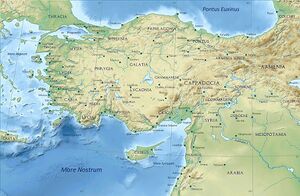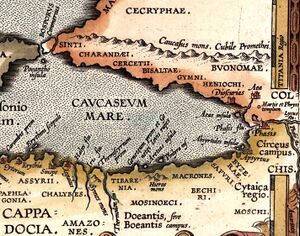Chalybes
| Author:Laxman Burdak, IFS (R) |


Chalybes and Chaldoi were peoples mentioned by classical authors as living in Pontus and Cappadocia in northern Anatolia during Classical Antiquity. The ancient Greeks connect the Chalybes with Scythians.[1]
Variants
- Chalybes /ˈkælɪbiːz/
- Ancient Greek: Χάλυβες/Χάλυβοι,
- Georgian: ხალიბები)
- Chaldoi (Ancient Greek: Χάλδοι, Armenian: Խաղտիք, romanized: Xałtik')
- Chalybe from Hittite Khaly-wa, "land of Halys River"
- Chalybs
- Khalabes
Location
Their territory was known as Chaldia, extending from the Halys River to Pharnakeia and Trabzon in the east and as far south as eastern Anatolia.
Jat clans
History
The Chaldoi, Chalybes, Mossynoikoi, and Tibareni, are counted among the first ironsmith nations by classical authors.[2] Χάλυψ, the tribe's name in Ancient Greek, means "tempered iron, steel", a term that passed into Latin as chalybs, "steel". Sayce derived the Greek name Chalybe from Hittite Khaly-wa, "land of Halys River".[3] More than an identifiable people or tribe, "Chalybes" was a generic Greek term for "peoples of the Black Sea coast who trade in iron"[4] or "a group of specialised metalworkers".[5]
The main sources for the history of the Chaldoi are accounts from classical authors, including Homer, Strabo, and Xenophon. In Xenophon's Cyropaedia, Cyrus the Great helps the Armenians and Chaldians resolve a dispute over agricultural land.[6]
In Roman times, the Chaldaei (homonymous but unrelated to the Semitic Chaldeans[7][8]) and Chalybes are mentioned by Plutarch (Lucull. c. 14) as settled in Pontus and Cappadocia, or the Pontus Cappadocicus section of the Roman province of Pontus.
Pliny the Elder mentioned the Armenochalybes, a tribe residing between Trebizond and Armenia.[9]
Despite the ancient Greeks connecting the Chalybes to Scythians, some modern historians argue the Chalybes were a Georgian tribe. Historian Kalistrat Salia claims the Georgian ethnicity of the Chalybes is "indisputable". According to Sallia, the Zans, a Kartvelian ethnic group from present-day Turkey, are their descendants.[10] However, the one surviving word from the Chaldian language, Kakamar (the Chaldian name for the Black Sea), points toward an Indo-European connection.[11]
Mention by Pliny
Pliny [12] mentions...We find here the nations of the Genetæ7 the Chalybes8, the town of Cotyorum9, the nations of the Tibareni and the Mossyni, who make marks upon their bodies,....
7 Strabo speaks of a promontory called Genetes; and Stephanus Byzantinus mentions a river and port of the same name.
8 Strabo places the Chaldei, who, he says, were originally called Chalybes, in that part of the country which lies above Pharnacia (the modern Kerasunt).
9 Or Cotyora. According to Xenophon, this was a colony of Sinope, which furnished supplies for the Ten Thousand in their retreat. The place was on a bay called after the town. Hamilton, in his Researches, &c., Vol. i., is of opinion that Cotyorum may have stood on the site of Ordou, where some remains of an ancient port, cut out of the solid rock, are still visible. He remarks, however, that some writers suppose that Cotvora was the modern bay of Pershembah, which is more sheltered than Ordou. Cotyora was the place of embarkation of the Ten Thousand.
Mention by Pliny
Pliny[13] mentions Troglodytice....We learn also from the same author that some nations of the Troglodytae have the name of Therothoæ28, being so called from their skill in hunting. They are remarkable for their swiftness, he says, just as the Ichthyophagi are, who can swim like the animals whose element is the sea. He speaks also of the Bangeni, the Gangoræ, the Chalybes, the Xoxinæ, the Sirechæ, the Daremæ, and the Domazames.
28 Apparently meaning in the Greek the "jackal-hunters," θηροθῶες. For an account of this animal, see B. viii. c. 52, and B. xv. c. 95.
References
- ↑ Apollonius Rhodius. Tr. by R. Merkel, by Edward P. Coleridge. The Argonautica. pp. 49, 65.
- ↑ Strabo, xi., 14.5
- ↑ Maya Vassaleva (31 December 1998). "Greek ideas of the north and the east". In Tsetskhladze, Gocha R. (ed.). The Greek Colonisation of the Black Sea Area. Franz Steiner Verlag. p. 74. ISBN 978-3515073028.
- ↑ I. M. Diakonoff The Pre-history of the Armenian People, Yerevan
- ↑ Erb-Satullo, Nathaniel L.; Gilmour, Brian J.J.; Khakhutaishvili, Nana (2020). "The metal behind the myths: iron metallurgy in the south-eastern Black Sea region". Antiquity. 94 (374): 401–419. doi:10.15184/aqy.2020.16. S2CID 216245696.
- ↑ Xenophon. Cyropaedia. Book 3. Chapter 2.
- ↑ Diakonov, Igor Mikhailovich (1984). The Pre-history of the Armenian People. Caravan Books. p. 162.
- ↑ Paradeisopoulos, Iordanis K. (2013). "A Chronology Model for Xenophon's Anabasis": 662.
- ↑ Pliny. The Natural History. Book 6. Chapter 10.
- ↑ Salia, Kalistrat (1983). History of the Georgian Nation. Madison, WI: University of Wisconsin. p. 181.
- ↑ Robert H. Hewsen. Armenia: A Historical Atlas. University of Chicago Press. 2001.
- ↑ Natural History by Pliny Book VI/Chapter 4
- ↑ Natural History by Pliny Book VI/Chapter 34
Back to Jat Places

